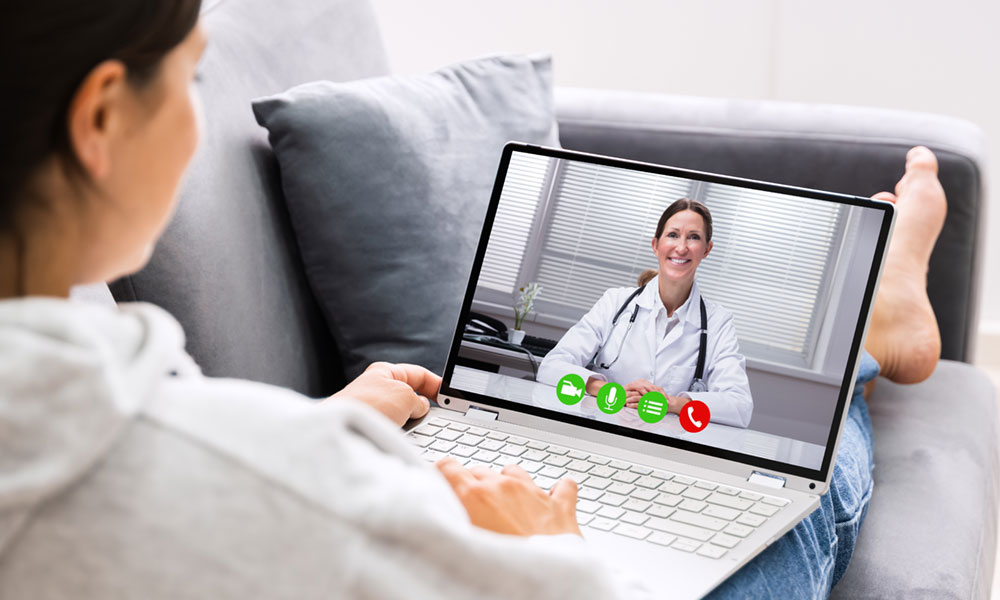A tool during the pandemic, it continues to evolve
By Deborah Jeanne Sergeant

As the pandemic caused businesses everywhere to try to reduce foot traffic, healthcare and mental health providers turned to telehealth to treat patients with certain non-urgent needs once telehealth was approved by the Centers for Medicare & Medicaid Services.
CMS is the agency within the U.S. Department of Health and Human Services that administers the nation’s major healthcare programs.
Before COVID-19 hit, few patients and providers exhibited interest in telehealth. However, its acceptance has become one of the unexpected and positive outcomes of the pandemic—and it’s here to stay.
Bhavneet Walia, assistant professor of public health at Syracuse University, found in her research that more than 40% of health care professionals polled will continue with telehealth post-pandemic.
“Originally, it started to increase access for rural people or those with some sort of disability where it was hard to see a physician,” Walia said. “That was the original incentive. With the pandemic, I think that it became a necessity.”
Currently, close to 60% of visits are via telehealth.
Walia said that initially, providers and their administrative staff had a bit of a scramble to develop and learn both the technology and the procedure for telehealth. They had to figure out how to keep the patient’s health information secure to comply with privacy requirements in HIPAA law under these unusual circumstances. They also had to walk some patients through how to use telehealth.
“At this point, I do feel that the physicians are very quickly getting comfortable in solving problems and figuring out ways to do this,” Walia said. “It’s more systematic. I think it definitely increases access. The physicians are realizing that.”
Increasing access is not only important to those who lack transportation, ease of mobility, childcare and a nearby provider (some rural residents drive more than two hours round-trip), but also because of the nationwide physician shortage.
Technology issues aside, telehealth visits are more efficient and can allow providers to see more patients in a day. Barriers to care such as bad driving conditions need not cancel a visit again.
“I see this going in a very positive way,” Walia said. “My research covered the physician’s side of this. I see a really bright future and increasing access at a very large scale.”
Patients also seem to like telehealth.
“I believe the use of telehealth has been a welcome addition to the St. Joseph physician practices,” said Austin Tsai, chief medical information officer at St. Joseph Hospital.
Tsai cited follow-up visits for depression or anxiety as examples of visits well-suited for telehealth for most patients.
“We have had many patients who have been elated to have telehealth as an option during these stressful times,” Tsai said. “It may allow people to avoid taking time off from work or having to find someone to watch their kids just to go to the doctor’s office. With improved follow-up, this allows us to provide even better patient care. In addition, telehealth can allow us to better assess the severity of cases to direct patients to the appropriate care.”

For people who feel stigma about their issue, telehealth can provide more privacy and thus increase the chance that they will seek professional help. That could be the reason behind the initial increase in compliance observed at Crouse Health. Monika Taylor, licensed clinical social worker and director of Addiction Treatment Services at Crouse Health, said that convenience or novelty could be other reasons.
“About three months into it, the initial increase in compliance bottomed out,” she said.
She thinks that ideally, a hybrid model would allow patients to seek care whichever way they prefer. Each offers advantages. Online the patient’s facial expressions and whole body are hard to observe and are impossible to note on the phone. Appearance can offer clues about the patient’s condition. Does she look tired? Why are his clothes untidy? Why does she have a bad odor? Why is he unsteady on his feet? Those types of clues are lost during virtual meetings. For some people, building a doctor-patient relationship is harder online.
Telehealth can offer a few advantages to caregivers when evaluating patients. They can learn more about their home life and see them more relaxed in their surroundings—providing they feel comfortable with the platform.
“The non-verbal is as important as the verbal,” Taylor said. “I feel it is really important as a field that we have telepractice moving forward beyond the epidemic.”
She hopes that reimbursement for telehealth at the same rate as in-person visits will continue.
“At the height of the pandemic, about 85% of counseling sessions at Crouse Health Addiction Treatment Services were delivered telephonically or using a videoconferencing platform,” Taylor said. “For patients lacking access to the technology, in-person individual sessions continued to be available using PPE, while following social distancing and infection control guidelines.”
Physician Micheal Stephens, associate chief medical officer and primary care provider at Oswego Family Physicians, said his practice’s in-person visits have decreased from 67% to 90% since the height of the pandemic. But he does not think that means telehealth is going away.
“For mental health, definitely improves no-show rates, patient compliance and patient satisfaction,” he said. “There’s not much of a physical exam with mental health.”
For generally healthy patients, telehealth may be helpful in addressing some routine issues, such starting an antibiotic for a patient presenting with classic urinary tract infection who has had these in the past. Or someone whose blood pressure machine is accurate and needs changes in medication.
“We can reduce ER and urgent care visits where costs are higher,” Stephens said. “There is a decreased costs and reduction in overhead as there’s less time with a nurse screening a patient, check-in and check-out.”
Issues like a sick child may be tougher to diagnose remotely. Or vague symptoms that could mean any number of illnesses or injuries. Stephens fears this could lead to over-prescription of antibiotics, which can lead to resistance issues.
Typically, an RN triages patients to help determine who needs to come in and who can be seen remotely.
“It’s definitely not for everything,” Stephens said. “We still encourage adult health exams and well child to in-person visits for preventative medicine.
“All of this will continue to evolve and we’ll continue to get better at it. But we need fed and state direction and what payors will pay. Medicaid, Medicare and BlueCross BlueShield will continue to pay telehealth through March 2022. But after that, they won’t pay for certain diagnosis codes. There has to be the appropriate bounds.”
Telehealth is also mostly out of reach for a few populations, including those who lack high-speed internet or a device to use it and for those who do not know how to use the technology. These are barriers, according to Stefania Buta, CNY Community Outreach & Organizer for New York Statewide Senior Action Council.
“We don’t have equitable and affordable digital infrastructure,” Buta said. “They don’t have the connection to their healthcare providers. It’s wonderful that telehealth has made healthcare more accessible, but a lot of people have been left behind.”
To help make telehealth accessible to all, her organization has launched telehealth access sites at local agencies in Oswego County this summer, in addition to connections at local libraries. She also hopes to offer digital literacy classes in Fulton and Oswego in the fall.
“Telehealth isn’t going anywhere,” Buta said. “That’s why we need to figure out community-based solutions until we make digital accessible and affordable to all New Yorkers.”



